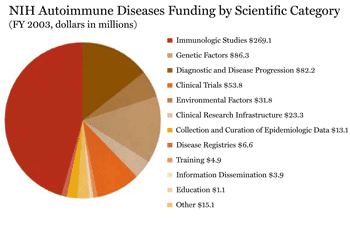 |
|
Yvonne Norton addresses a reception at the UK House of Commons at the launch of
Lupus - A GP Guide to Diagnosis, which she compiled. Holding the microphone
is Graham Hughes, a consultant physician at St. Thomas Hospital in London.
|
|
Courtesy of Yvonne Norton
|
Autoimmune diseases
Because autoimmune diseases can be hard to diagnose, and because many of them are rare, collecting data on their prevalence is a real challenge, says epidemiologist Glinda Cooper of the US Environmental Protection Agency. "When you talk about autoimmune diseases as a general category, it is hard to find good data to get a grasp of it," she says. The best estimates from the ADCC suggest that autoimmune diseases affect 23.5 million Americans, which represents as much as eight percent of the population. Plus, for reasons that aren't clear, the incidence of some autoimmune diseases seems to be increasing.
According to Noel Rose, director of the Center for Autoimmune Disease Research at Johns Hopkins School of Public Health and lead author of the ADCC report, the wide margin of uncertainty in that report's figures reflects a lack of solid data on autoimmune disease epidemiology in the United States. The challenge becomes even bigger globally. "The usual 'wisdom' is that autoimmune diseases are a problem mostly of developed countries," he says. "That may or may not be true; I've never been completely comfortable with the idea."
Still, scientists do know one thing about the epidemiology of autoimmune diseases: Women are affected more than men, at least in most cases. "We know that these diseases occur predominantly in women in their childbearing years, just when they have the biggest family responsibilities," says Rose.
This imbalance varies from disease to disease, says Cooper. In 2003, she coauthored a report1 on the epidemiology of autoimmune diseases, perhaps the most detailed publication on the topic so far. That report shows that in the more common conditions, such as MS, the imbalance tilts so that affected patients are roughly two-thirds female. "In some diseases, however, the degree of disproportion is very extreme," Cooper says. For example, at least 85% of patients with thyroiditis, systemic sclerosis, systemic lupus erythematosus, and Sjögren disease are female. In data from the Centers for Disease Control and Prevention for 1995, well-defined autoimmune diseases were one of the top-10 causes of death for women under the age of 65 years.2
The struggle to track these diseases matches the pharmaceutical industry's failure to treat them. For example, drugs for rheumatoid arthritis evolved from injectable gold in the 1930s to biologics today, but treatment results remain mediocre. According to Anthony Manning, vice president and global head of inflammation, autoimmunity, and transplant research at Roche, only about one-third of patients with rheumatoid-arthritis get "significant benefit," even with today's best therapies.
Such lacklustre results probably arise from rheumatoid arthritis' heterogeneity, varying in mechanism between individuals and within the same individual over time. Many other autoimmune diseases include similar variability, which thwarts effective treatment. Still, some members of the pharmaceutical community feel optimistic about improving results in the very near future. "Five years ago, we didn't have the plethora of tools that we have today," says Andrew C. Chan, vice president of research immunology and antibody engineering at Genentech. "If you only have one or two tools, it's hard to go and attack any disease and say, 'I have the answer.' It's like having a hammer, and you're walking around looking for the nail."
 |
The sheer numbers of patients with autoimmune diseases places an enormous cost on health systems. In USA, for example, "there's no doubt that about 60% of our healthcare budget is on the treatment of autoimmune diseases and their complications," says Imran Khan, director of the Cidpusa, most of it spent on diabetes, multiple sclerosis, and arthritis. "There's no question we're talking about a major burden, and these costs are increasing every year."
I "In the past, most autoimmune diseases were treated with relatively cheap drugs like prednisone, which costs about $30 a month," says Ladd. "That's now changing." For example, the antitumor necrosis factor (TNF)-alpha drug Remicade (infliximab) costs about $1,250 per month, and it is prescribed for ankylosing spondylitis, Crohn disease, psoriatic arthritis, rheumatoid arthritis, and ulcerative colitis. "The drug is a very good breakthrough, but the costs in the future will be enormous," Ladd says.